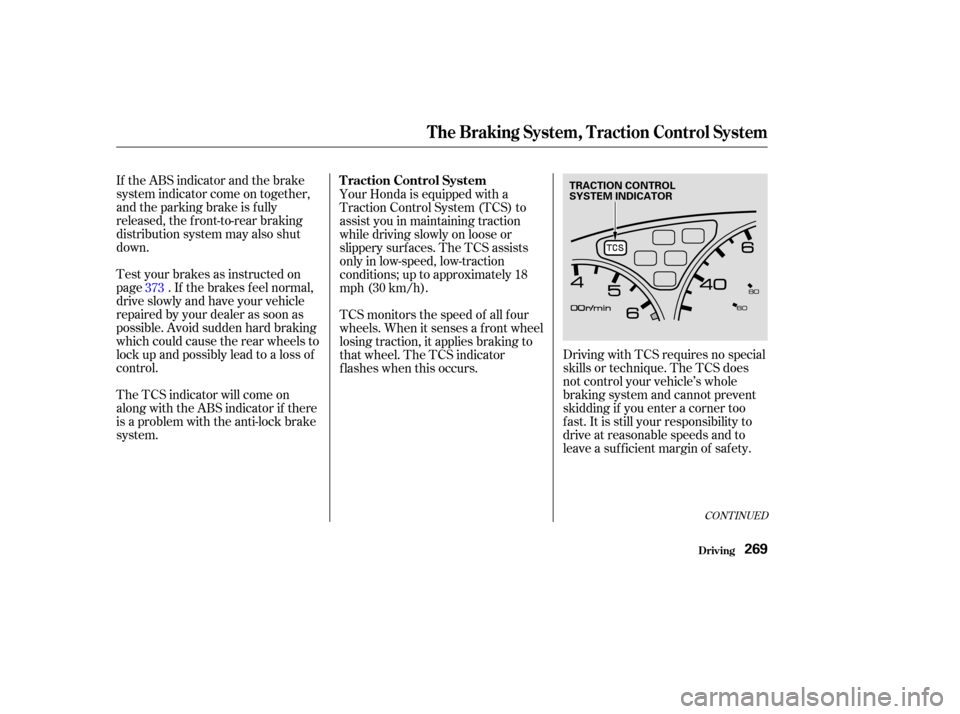Page 272 of 415

CONT INUED
If the ABS indicator and the brake
system indicator come on together,
and the parking brake is f ully
released, the front-to-rear braking
distribution system may also shut
down.
Test your brakes as instructed on
page . If the brakes f eel normal,
drive slowly and have your vehicle
repaired by your dealer as soon as
possible. Avoid sudden hard braking
which could cause the rear wheels to
lock up and possibly lead to a loss of
control.Driving with TCS requires no special
skills or technique. The TCS does
not control your vehicle’s whole
braking system and cannot prevent
skidding if you enter a corner too
f ast. It is still your responsibility to
drive at reasonable speeds and to
leave a sufficient margin of safety.
The TCS indicator will come on
alongwiththeABSindicatorif there
is a problem with the anti-lock brake
system. Your Honda is equipped with a
Traction Control System (TCS) to
assist you in maintaining traction
while driving slowly on loose or
slippery surf aces. The TCS assists
only in low-speed, low-traction
conditions; up to approximately 18
mph (30 km/h).
TCS monitors the speed of all f our
wheels. When it senses a f ront wheel
losing traction, it applies braking to
that wheel. The TCS indicator
f lashes when this occurs.
373
The Braking System, Traction Control System
Driving
Traction Control System
269
TRACTION CONTROL
SYSTEM INDICATOR
Page 274 of 415

If the TCS indicator comes on and
stays on for more than 10 minutes
while driving, pull to the side of the
road when it is saf e and turn of f the
engine. Reset the system by
restarting the engine, and watch the
TCS indicator. If the indicator
remains on, or comes back on while
driving, have the system inspected
by your Honda dealer. You can still
drive the vehicle without TCS.
This indicator will come on along
with the ABS indicator if there is a
problem in the anti-lock brake
system (seeon page
).
The TCS indicator may occasionally
come on f or one or two seconds and
then go out. This is normal.
The Traction Control System turns
on every time you start the engine,
even if you turned it of f the last time
you drove the vehicle.
The TCS indicator comes on or
f lashes under the f ollowing condi-
tions:
When you turn the ignition switch
to ON (II).
When you manually turn of f TCS.
It f lashes when TCS is regulating
wheelspin.
If the system’s diagnostics senses
a problem with TCS, the indicator
will come on and stay on.
If the brakes overheat, the
indicator will come on. 268
Traction Control System
Driving
ABS Indicator
T CS Indicat or
271
Page 276 of 415
�µCheck your tires
f requently f or wear and proper
pressure. Both are important in
preventing ‘‘hydroplaning’’ (loss of
traction on a wet surface). In the
winter, mount snow tires on all f our
wheels f or the best handling.
Watch road conditions caref ully,
they can change f rom moment to
moment. Wet leaves can be as slip-
pery as ice. ‘‘Clear’’ roads can have
patches of ice. Driving conditions
can be very hazardous when the
outside temperature is near f reezing.
The road surf ace can become
covered with areas of water puddles
mixed with areas of ice, so your
traction can change without warning.
Be caref ul when downshif ting. If
traction is low, you can lock up the
drive wheels f or a moment and cause
askid. Be very cautious when passing, or
beingpassedbyothervehicles.The
spray f rom large vehicles reduces
your visibility, and the wind buf f eting
can cause you to lose control.
Driving in Bad Weather
Driving
Traction
273
Page 293 of 415

�µ
�µ�Î
�Î
�Ì
�Ì �Ì�Î
�Ì�Î
Follow the Severe Conditions
Maintenance Schedule if you
drive your vehicle
under one or more of the
f ollowing conditions:
Driving less than 5 miles (8
km) per trip or, in f reezing
temperatures, driving less
than 10 miles (16 km) per trip.
Driving in extremely hot
[over 90°F (32°C)] conditions.
Extensive idling or long
periods of stop-and-go driving,
such as a taxi or a commercial
delivery vehicle.
Trailer towing, driving with a
roof rack, or driving in
mountainous conditions.
Driving on muddy, dusty, or
de-iced roads.
Follow the Maintenance
Schedule f or Severe Conditions.
MAINLY
Maint enance
U.S. Owners
Canadian Owners
290
Visually inspect the following items: Replace every 3,750 miles (6,000 km) or 6 months
Check oil and coolant at each fuel stop
Service at the indicated
distance or time whichever
comes first.
miles x 1,000
km x 1,000
months
120,000 miles (192,000 km) or 10 years, then every 60,000 miles (96,000 km) or 5 years
Tie rod ends, steering gear box, and boots
Suspension components
Driveshaft boots
Brake hoses and lines (including ABS)
All fluid levels and conditions of fluids
Cooling system hoses and connections
Exhaust system
Fuel lines and connections
Lights and controls
Vehicle underbody Every 7,500 miles (12,000 km) or 6 months
Rotate tires every 7,500 miles (12,000 km)
Inspect every 7,500 miles (12,000 km) or 6 months 30
48
24
60
96
4890
144 72 120
192
96
Every 3 years (independent of mileage)
15
24
12
45
72
3675
120 60 105
168
84
See information on maintenance and emissions warranty, last column, page . Refer to page for replacement
information under special driving
conditions. Refer to page for replacement
information under special driving
conditions.
Replace engine oil and oil filter
Check engine oil and coolant
Replace air cleaner element
Use normal schedule except in dusty
conditions
Inspect valve clearance
Replace spark plugs
Inspect and adjust drive belts
Inspect idle speed
Replace engine coolant
Replace transmission fluid
Inspect front and rear brakes
Replace brake fluid
Check parking brake adjustment
Replace dust and pollen filter
Lubricate all hinges, locks and latches
Rotate tires (Check tire inflation and condition
at least once per month) Adjust only if noisy
1:
2:
: 287322
323
Replace timing belt and inspect water pump,1
2
Maintenance Schedule for Severe Conditions
Page 294 of 415

�µ�µ
�Ø
�Ø
�Ø
�Ø
�Ø
�Ø
�Ø
�Ø
�Ø
�Ø
�Ø
�Ø
�Ø
�Ø
�Ø
�Ø
�Ø
�Ø
�Ø
�Ø
�Ø
�Ì
�Ì
�Î
�Î�Ì
�Ì
�Î
�Î
CONT INUED
Maint enance291
A, B, C, D
U.S. Owners
Canadian Owners
A
B
C
D
Service at the indicated distance or time, whichever comes first. Do the items in as required for each distance/time interval.
Refer to page to determine which schedule to use.Use the Maintenance Schedule for Severe Conditions.
3,750 mi/6,000 km
7,500 mi/12,000 km/6 mos
11,250 mi/18,000 km
15,000 mi/24,000 km/1 yr
18,750 mi/30,000 km
22,500 mi/36,000 km
26,250 mi/42,000 km
30,000 mi/48,000 km/2 yrs
33,750 mi/54,000 km
37,500 mi/60,000 km
41,250 mi/66,000 km
3yrs
45,000 mi/72,000 km/3 yrs
48,750 mi/78,000 km
52,500 mi/84,000 km
60,000 mi/96,000 km/4 yrs
63,750 mi/102,000 km Replace engine oil and filter.
Inspect front and rear brakes.
Rotate tires (follow pattern on page
326).
Inspect tie rod ends, steering gearbox and boots.
Inspect suspension components.
Inspect driveshaft boots.
Check parking brake adjustment.
Replace air cleaner element.
Lubricate all hinges, locks and latches with
multipurpose grease.
Inspect brake hoses and lines (including ABS).
Check all fluid levels, condition of fluids, and check
for leaks.
Inspect cooling system hoses and connections.
Inspect exhaust system.
Inspect fuel lines and connections.
Check all lights.
Inspect the underbody.
Replace transmission fluid.
Inspect and adjust drive belts.
Replace dust and pollen filter.
Do item in A.
Do items in A, B.
Do item in A.
DoitemsinA,B,C.
Do item in A.
Do items in A, B.
Do item in A.
DoitemsinA,B,C,D.
Do item in A.
Do items in A, B.
Do item in A.
Replace brake fluid (independent of mileage)
DoitemsinA,B,C.
Do item in A.
Do items in A, B. Replace timing belt.
DoitemsinA,B,C,D.
Do item in A.
290
See information on maintenance and emissions warranty, last
column, page .
Check engine oil and coolant at each fuel stop.
Check and adjust valve clearance, cold engine, only if noisy.
See timing belt on page to determine need for replacement.
See dust and pollen filter on page for replacement information under special driving
conditions.
:
NOTE:
1:
2:
323
322
287
2
1,
Maintenance Schedule for Severe Conditions (listed by distance/time)
Page 305 of 415
Make sure the engine and radiator
are cool.
Turn the radiator cap counter-
clockwise, without pressing down
on it, until it stops. This relieves
any pressure remaining in the
cooling system.
Remove the radiator cap by
pushing down and turning
counterclockwise.The coolant level should be up to
the base of the f iller neck. Add
coolant if it is low.Put the radiator cap back on.
Tighten it f ully.
Pour coolant into the reserve tank.
Fill it to half way between the MAX
and MIN marks. Put the cap back
on the reserve tank.
Do not add any rust inhibitors or
other additives to your vehicle’s
cooling system. They may not be
compatible with the coolant or
engine components.
Pour the coolant slowly and caref ully
so you do not spill. Clean up any
spills immediately. Spilled coolant
could damage components in the
engine compartment.
3. 4.5.
6.
1.
2.
Cooling Syst em
Maint enance302
RADIATOR CAP RESERVE TANK
Page 306 of 415
CONT INUED
Thecoolingsystemshouldbe
completely drained and ref illed with
new coolant according to the time
and distance recommendations in
the maintenance schedule. Only use
Honda All Season Antif reeze/
Coolant Type 2.
Draining the coolant requires access
to the underside of the vehicle.
Unless you have the tools and
knowledge, you should have this
maintenance done by a skilled
mechanic.Turn the ignition ON (II). Turn
the heater temperature control
dial f ully clockwise or set the
climate control system to
90°F (32°C). Turn the ignition of f .
Openthehood.Makesurethe
engine and radiator are cool to the
touch.
Remove the radiator cap.Loosen the drain plug on the
bottom of the radiator. The
coolant will drain through the
splash guard. Drain the coolant
into an appropriate container.
1.
3.
2.
Replacing Engine Coolant
Cooling Syst em
Maint enance303
DRAIN PLUG
DRAIN BOLT
Page 307 of 415
When the coolant stops draining,
tightenthedrainplugatthe
bottom of the radiator.
Tighten the drain bolt at the rear
of the engine cylinder block
securely.
Tightening torque:
Remove the reserve tank f rom its
holder by pulling it straight up.
Drain the coolant into an
appropriate container, then put the
tank back in its holder.
Install a rubber hose on the drain
bolt in the back of the engine
block. Loosen the drain bolt. Drain
the coolant into an appropriate
container. 6.
4. 5. 7.
Cooling Syst em
Maint enance304
RESERVE TANK RESERVE
TANK CAP
HOLDER
7 lbf·ft (10 N·m , 1.0 kgf·m)